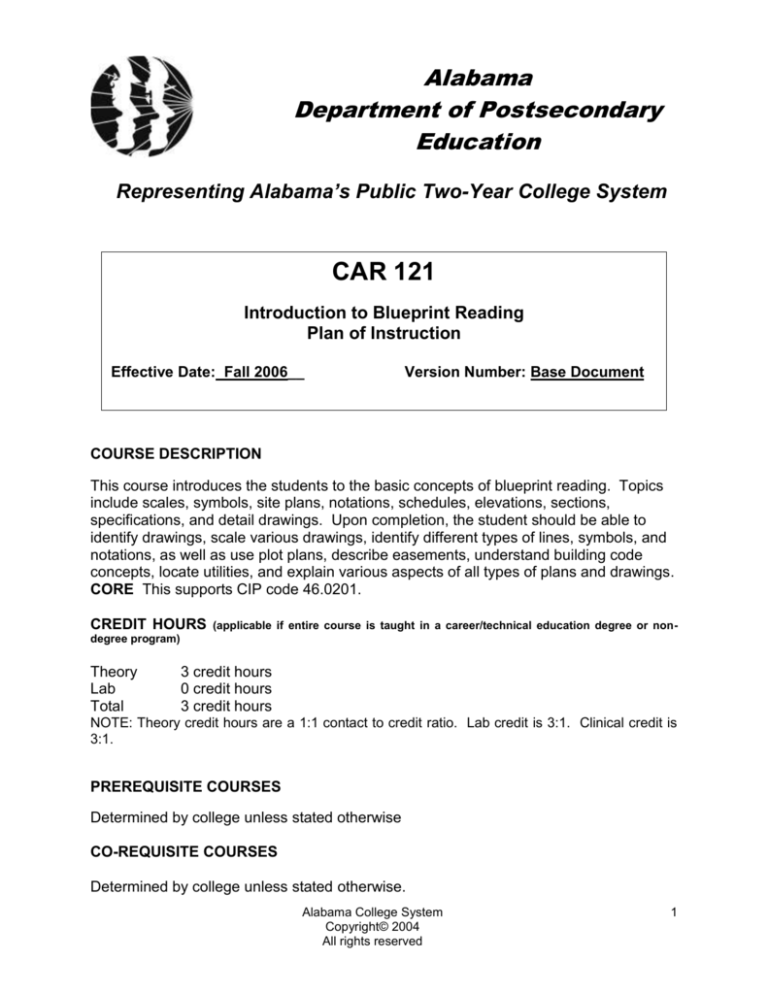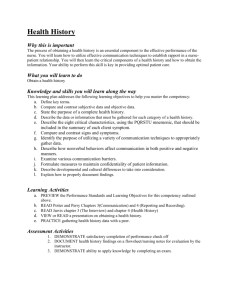
Alabama
Department of Postsecondary
Education
Representing Alabama’s Public Two-Year College System
CAR 121
Introduction to Blueprint Reading
Plan of Instruction
Effective Date: Fall 2006__
Version Number: Base Document
COURSE DESCRIPTION
This course introduces the students to the basic concepts of blueprint reading. Topics
include scales, symbols, site plans, notations, schedules, elevations, sections,
specifications, and detail drawings. Upon completion, the student should be able to
identify drawings, scale various drawings, identify different types of lines, symbols, and
notations, as well as use plot plans, describe easements, understand building code
concepts, locate utilities, and explain various aspects of all types of plans and drawings.
CORE This supports CIP code 46.0201.
CREDIT HOURS
(applicable if entire course is taught in a career/technical education degree or non-
degree program)
Theory
Lab
Total
3 credit hours
0 credit hours
3 credit hours
NOTE: Theory credit hours are a 1:1 contact to credit ratio. Lab credit is 3:1. Clinical credit is
3:1.
PREREQUISITE COURSES
Determined by college unless stated otherwise
CO-REQUISITE COURSES
Determined by college unless stated otherwise.
Alabama College System
Copyright© 2004
All rights reserved
1
Introduction to Blueprint Reading
CAR 121
INSTRUCTIONAL NOTE: The instructor needs to have a scaled set of drawings
present for student success.
INDUSTRY/PROFESSIONAL COMPETENCIES
Comprehend blueprint scales, symbols, notations, lines, and drawing identifications.
Use plans, schedules, elevations, sections, specifications, and detail drawings.
GENERAL INSTRUCTIONAL OBJECTIVES
The cognitive objective for this course is for each student to comprehend foundational
knowledge of blueprints.
The performance objective of this course is for each student to apply foundational
knowledge of blueprints.
INDUSTRY/PROFESSIONAL COMPETENCIES/STUDENT PERFORMANCE
Unless otherwise indicated, evaluation of student’s attainment of cognitive and
performance objectives is based on knowledge gained from this course. During
performance evaluations, students will be provided necessary tools, equipment,
materials, specifications, and any other resources necessary to accomplish the task.
Specifications may be in the form of, but not limited to, certification agencies, national
and state codes, health care facility policies, locally developed lab/clinical assignments,
or any combination of specifications.
Alabama College System
Copyright© 2004
All rights reserved
2
Introduction to Blueprint Reading
CAR 121
MODULE A – INTRODUCTION TO BLUEPRINTS
INDUSTRY
STUDENT PERFORMANCE OBJECTIVES
COMPETENCIES
A1.0 Comprehend
A1.1 Identify the different drawing types and scales. (2)
blueprint scales,
symbols, notations,
A1.2 Identify the different parts of blueprints. (2)
lines, and drawing
identifications. (2b)
A1.3 Identify different line types. (2)
A1.4 Identify different symbols. (2)
A1.5 Identify abbreviations and give their proper full
names. (2)
A1.6 Locate specified parts of a drawing. (2)
A1.7 Give the dimensions of specified parts of a
drawing. (2)
A1.8 Identify specified distances. (2)
A2.0 Value the importance
of being able to read
blueprints. (*3)
A2.1 This competency will be evaluated throughout the
course.
ENABLING OBJECTIVES/KEY INDICATORS
A1.1.1 Explain the differences between various types of drawings and
their scales.
KSA
Indicators
B
A1.2.1 Describe the different parts of a blueprint.
A
A1.3.1 Describe various types of lines and explain their purposes.
B
A1.4.1 Describe various symbols.
A
A1.5.1 Define abbreviations including use of full names.
A
A1.6.1 Determine the location and symbols for specified objects on the
print.
b
A1.7.1 Draw specified dimensions.
b
A1.8.1 Differentiate between various distances.
b
Alabama College System
Copyright© 2004
All rights reserved
3
Introduction to Blueprint Reading
CAR 121
MODULE B – PLAN VIEW DRAWINGS
INDUSTRY/PROFESSIONAL
STUDENT PERFORMANCE OBJECTIVES
COMPETENCIES
B1.0 Use plans, schedules, B1.1 This competency is measured cognitively.
elevations, sections,
specifications, and
detail drawings. (B)
B2.0 Demonstrate an
appreciation for the
usefulness of plan
view drawings. (*3)
B2.1 This competency will be evaluated throughout
the course.
ENABLING OBJECTIVES/KEY INDICATORS
B1.1 1 Explain the use of plot/site plans.
B1.1.2 Describe how easements are identified on a site plan.
B1.1.3 Explain the relationship of building codes and site plans.
B1.1.4 Explain how utilities are located on site plans.
B1.1.5 Explain various aspects of foundation plans.
B1.1.6 Explain various aspects of floor plans.
B1.1.7 Explain various aspects of framing plans.
B1.1.8 Explain various aspects of elevations.
B1.1.9 Explain various aspects of section and detail drawings.
B1.1.10 Explain various schedules and their purposes.
B1.1.11 Explain the purpose of written specifications.
Alabama College System
Copyright© 2004
All rights reserved
KSA
Indicators
B
B
B
B
B
B
B
B
B
B
B
4
Introduction to Blueprint Reading
CAR 121
COURSE CONTENT OUTLINE
MODULE A – INTRODUCTION TO BLUEPRINTS
Introduction to Blueprints
Components of Blueprints
o Line Types
o Symbols
o Notations and Abbreviations
o Scales
o Drawing Identification
o Schedules
Locations
Dimensions
Distances
MODULE B – DRAWING VIEWS
Plot/Site Plans
O Easements
O Codes
O Utilities
Foundation Plans
Floor Plans
Framing Plans
Elevations
Section Drawings
Detail Drawings
Schedules
o Plumbing
o Electrical
o Doors
o Windows
o Headers
o HVAC
Specifications
Alabama College System
Copyright© 2004
All rights reserved
5
Introduction to Blueprint Reading
CAR 121
RECOMMENDED METHODS OF EVALUATION: The tables of specifications below
identify the number of cognitive (knowledge) enabling objectives, psychomotor
(performance) objectives, and affective (attitudinal) objectives per module. Instructors
should develop sufficient numbers of evaluation items to ensure complete
coverage of each cognitive and/or psychomotor objective identified in each
module. For cognitive objectives, use appropriate written test type based on the
complexity indicator for each objective. Create comprehensive, checklist evaluations for
each psychomotor objective. Affective objectives may be used for graduation
criteria, but should not be assigned a letter grade.
Facts/Nomenclature (A/a): Multiple Choice, Fill-in, List, Matching, Alternative
Response (true/false or yes/no)
Principles/Procedures (B/b): Multiple Choice, Fill-in, List, Short Answer
Analysis/Operating Principles (C/c): Multiple Choice, Short Answer, Essay
Evaluation/Complete Theory (D/d): Multiple Choice, Short Answer, Essay
Performance Objectives (1/2/3/4): Observation, Comprehensive checklist
Affective Objectives (*1/*2/*3/*4/*5): Likert scale, Go/no go, Survey, Observation
Checklist
COGNITIVE TABLE OF SPECIFICATIONS
Cognitive Domain
Module A
Module B
Total
Facts/
Nomenclature
Principles/
Procedures
3
4
11
15
3
Analysis/
Operating
Principles
Evaluation/
Complete
Theory
Minimum
Total Test
Items
7
11
18
PSYCHOMOTOR TABLE OF SPECIFICATIONS
Psychomotor Domain
Limited
Proficiency
8
Minimum
Total
Evaluations
8
8
8
Partially
Proficient
Module A
Module B
Total
Proficient
Highly
Proficient
AFFECTIVE OBJECTIVES TABLE OF SPECIFICATIONS
Affective Domain
Receiving
*1
Module A
Module B
Total
Responding
*2
Valuing
*3
Organization
*4
1
1
2
Alabama College System
Copyright© 2004
All rights reserved
Characterization
by Value
*5
Total
Objectives
1
1
2
6
Introduction to Blueprint Reading
CAR 121
Knowledge, Skills, and Abilities (KSA) Indicators
Value
Key Word(s)
Highly
Proficient
Affective
Knowledge
Knowledge of Skills
Performance
Ability
4
3
Proficient
2
Partially
Proficient
1
Limited Proficiency
Complete
Theory
Operating
Principles
d
c
b
Procedures
a
Nomenclature
D
Evaluation
C
Analysis
B
Principles
A
Facts
*5
Characterization by
Value
*4
Organization
*3
Valuing
*2
Responding
*1
Receiving
Definition
Performs competency quickly and accurately. Instructs
others how to do the competency.
Performs all parts of the competency. Needs only a spot
check of completed work.
Performs most parts of the competency. Needs help only on
hardest parts.
Performs simple parts of the competency. Needs to be told
or shown how to do most of the competency.
Predicts, isolates, and resolves problems about the
competency.
Identifies why and when the competency must be done and
why each step is needed.
Determines step-by-step procedures for doing the
competency.
Names parts, tools, and simple facts about the competency.
Evaluates conditions and makes proper decisions about the
subject.
Analyzes facts and principles and draws conclusions about
the subject.
Identifies relationship of basic facts and states general
principles about the subject.
Identifies basic facts and terms about the subject.
Acting consistently with the new value
Integrating a new value into one's general set of values, giving it some
ranking among one's general priorities
Showing some definite involvement or commitment
Showing some new behaviors as a result of experience
Being aware of or attending to something in the environment
Alpha Scale Values - Any item with an upper case letter (A, B, C, D) by itself is taught as general information on a topic. This information may be related to the
competency or encompass multiple competencies. Examples might include mathematical computations or knowledge of principles such as Ohm’s Law.
A lower case letter indicates a level of ”Knowledge of Skills." Individuals are taught information pertaining to performing a competency . These may be indicated
alone or in conjunction with a numerical scale value. A lower case letter by itself indicates the individual is not required to perform the task-just know about the task.
(example: Can state or explain procedures for doing a task).
Numerical Scale Values - The numbers reflect the levels the individual will be able to perform a competency. Number values are always accompanied by lower
case letters (i.e. 1a, 2b, 3c...etc.) in order to specify the level of knowledge of skills associated with the competency.
Example: An individual with a competency with a scale indicator of 3b has received training of knowledge of skills whereby he or she can determine the correct
procedures and perform with limited supervision; only requiring evaluation of the finished product or procedure.
Asterisk items indicate desired affective domain levels and are used alone to indicate the desired level for a given competency. They may be used independently or
with other indicators (i.e. 1a-*1, 2c-*3). If used with another indicator, separate with a hyphen.
NOTE: Codes indicate terminal values.
Alabama College System
Copyright© 2004
All rights reserved
7







